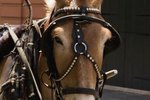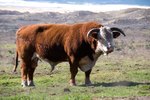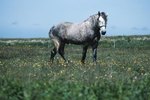
Oxen are cattle that are used as draft animals, and they have been used since around 4,000 BC. In some countries they're known as bullocks. Oxen are used for plowing, pulling wagons and carts, threshing grains and providing the pulling power for simple machines like millstones for grinding grain. They're normally used in pairs, and for heavy work like log-hauling there could be more than 10 pairs yoked to a single wagon.
Physical Characteristics
Oxen are used as working animals so they're normally larger breeds of cattle. They are mostly males, as these are naturally larger than females, and are usually castrated since steers are easier to manage than bulls. Bulls are used in some parts of the world, but females are rarely used as they're kept for producing milk and calves. Training begins at an early age, but steers are not regarded as fully grown until the age of 4, when they become known as oxen.
Temperament
A calm temperament is one of the most important requirements for an ox. They must have a willingness to respond to commands and be content to do the same sort of work day after day so long as they are well-fed and cared for. Hard-working oxen can wear their feet down and need to be shod so they can continue to work. They need to be able to accept being put in a shoeing sling or ox press and having their feet handled.
Training
Working oxen are normally trained as calves to accept a yoke and work as a pair. Each ox is always on the same side of the yoke. They must learn verbal commands for stop, go, back up, left and right and understand commands given by touch through a pole. As they get older the amount of time spent in the yoke and the load they must carry will increase. A good ox can also read signals from the body language of its teamster.
Comparison to Horses as Draft Animals
Oxen are slower than horses, but are capable of pulling a heavier load and working for a longer period than most horses. This makes them very suitable for a lot of agricultural work where endurance is more valued than speed. Oxen are less skittish than horses and are less likely to spook when they see something unfamiliar or hear loud noises. Oxen can be ridden just like horses can.
References
Resources
Photo Credits
-
Visage/Stockbyte/Getty Images




